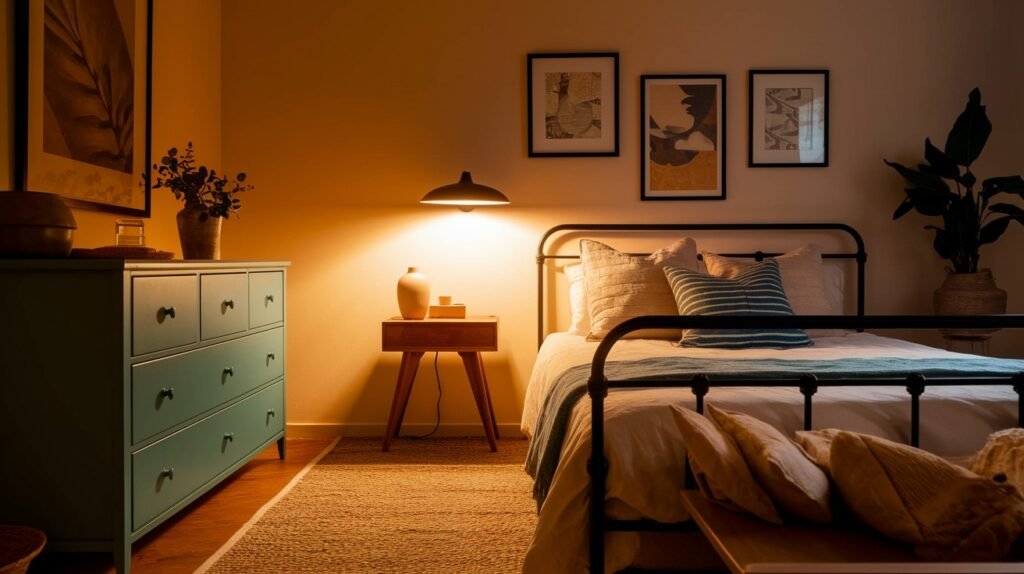Your bedroom furniture doesn’t match, and you’re wondering if that’s a problem. It’s not. Mismatched furniture can create a more personal and interesting space than perfectly coordinated sets.
Many people think they need to buy complete bedroom sets to have a good-looking room. This simply isn’t true. Mixed furniture styles can work beautifully together when done right.
In this article, you’ll find seven practical ideas for making mismatched bedroom furniture look intentional and stylish. We’ll show you how to create visual connections between different pieces, use color and texture to tie everything together, and arrange furniture for the best flow and appearance.
These aren’t complicated design tricks that require special skills. They’re simple strategies that anyone can use, regardless of budget or experience level.
By the end of this guide, you’ll know exactly how to make your mismatched furniture look like it belongs together. Your bedroom will feel more like you and less like a furniture showroom.
Simple Approaches for Mismatched Bedroom Furniture
Here are 7 approaches that you’re sure to love. Let’s get started:
1. Create a Unified Color Palette
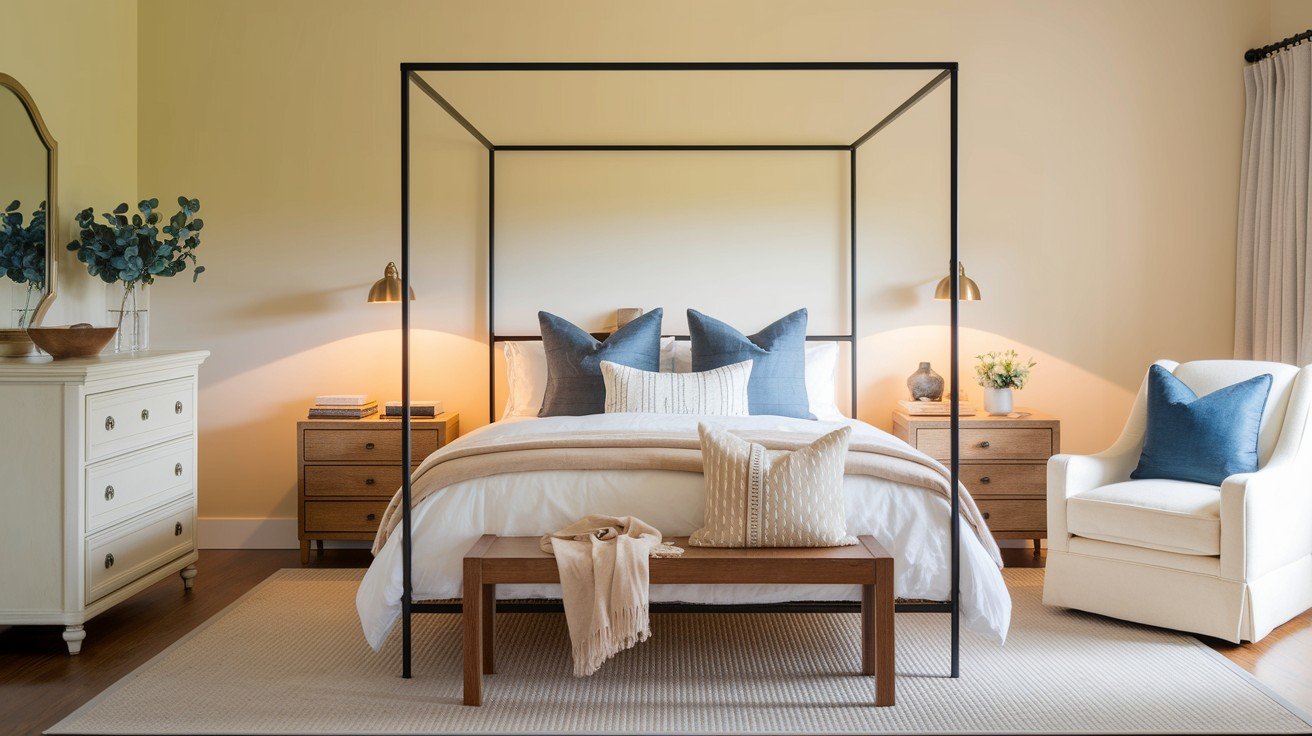
The easiest way to make mismatched furniture look intentional? Start with color. I always tell people to think of color as the glue that holds different furniture pieces together. When you have a dresser from the 1980s next to a modern nightstand, color can make them best friends instead of awkward roommates.
Begin with neutral foundations. Use white, gray, black, or cream for your larger pieces. These colors work with almost everything and won’t fight for attention in your room. Paint that old wooden dresser in soft white, keep your black metal bed frame as-is, and add a cream-colored chair in the corner.
But don’t stop there. Repeat colors strategically through smaller items. If your headboard has blue accents, add blue throw pillows to your chair. Do you have a wooden nightstand with warm tones? Place a lamp with a warm brass base on your dresser.
You can also coordinate paint colors across different furniture styles. A vintage vanity and a modern bookshelf, both painted in the same shade of gray, will suddenly look like they belong together.
Balance is key. If you have one bold red piece, don’t add three more red items. Instead, use that red sparingly in small accessories to tie everything together without overwhelming the space.
2. Focus on Material and Finish Harmony
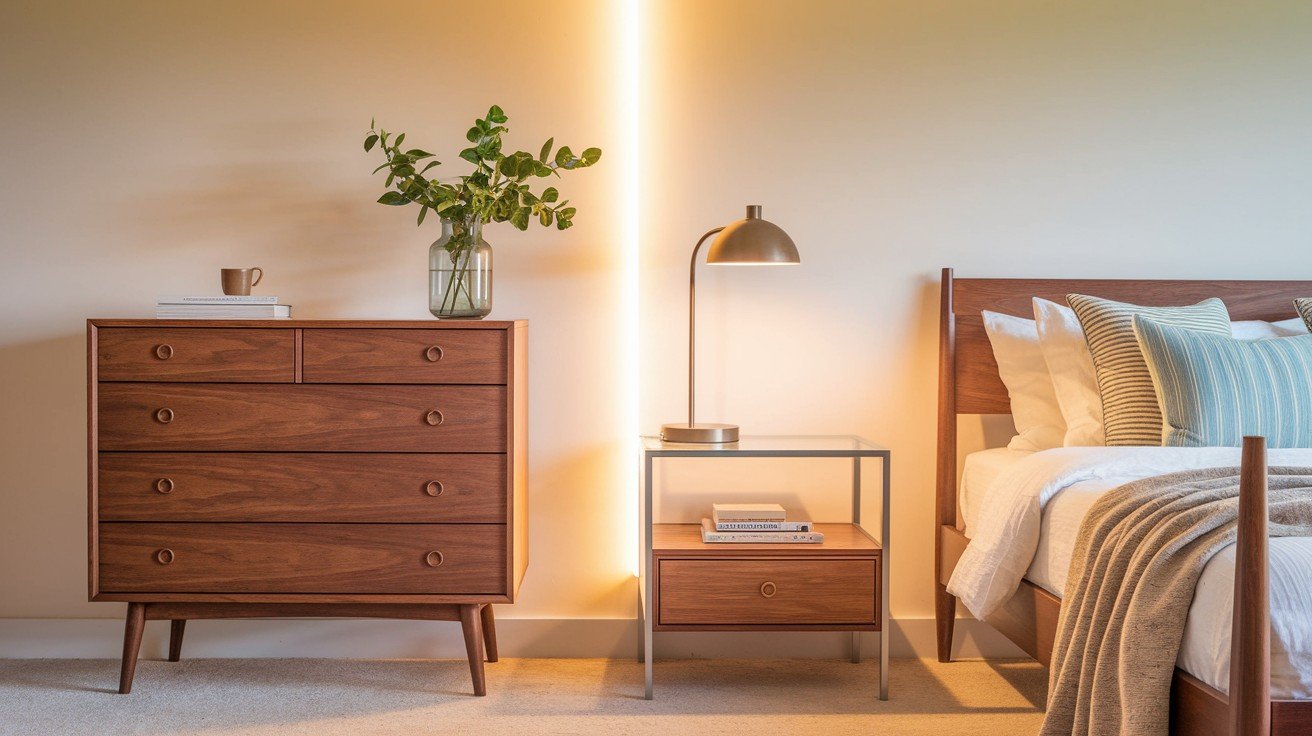
Materials matter more than you think. I’ve seen rooms where every piece of furniture was different, but they all looked great together because of smart material choices.
Start by coordinating wood stains across your different furniture styles. A mid-century dresser and a farmhouse nightstand can work together if they share the same warm walnut finish. Here’s the trick: Look at the undertones in your wood pieces. Match the undertones, not the exact wood type.
Avoid competing wood tones at all costs. Red oak next to maple creates visual chaos because they fight each other. Your eye doesn’t know where to look first.
Mix materials for visual interest. Combine wood with glass and metal to create layers in your room. A wooden bed frame pairs beautifully with a glass-top nightstand and metal lamp base. Each material complements the others without competing.
Use consistent hardware to tie different pieces together. Replace all your drawer pulls and cabinet knobs with the same finish. Brushed nickel hardware on your dresser, nightstand, and armoire will make them look like a family, even if they come from different decades. Small changes, big impact.
3. Start with One Statement Focal Point
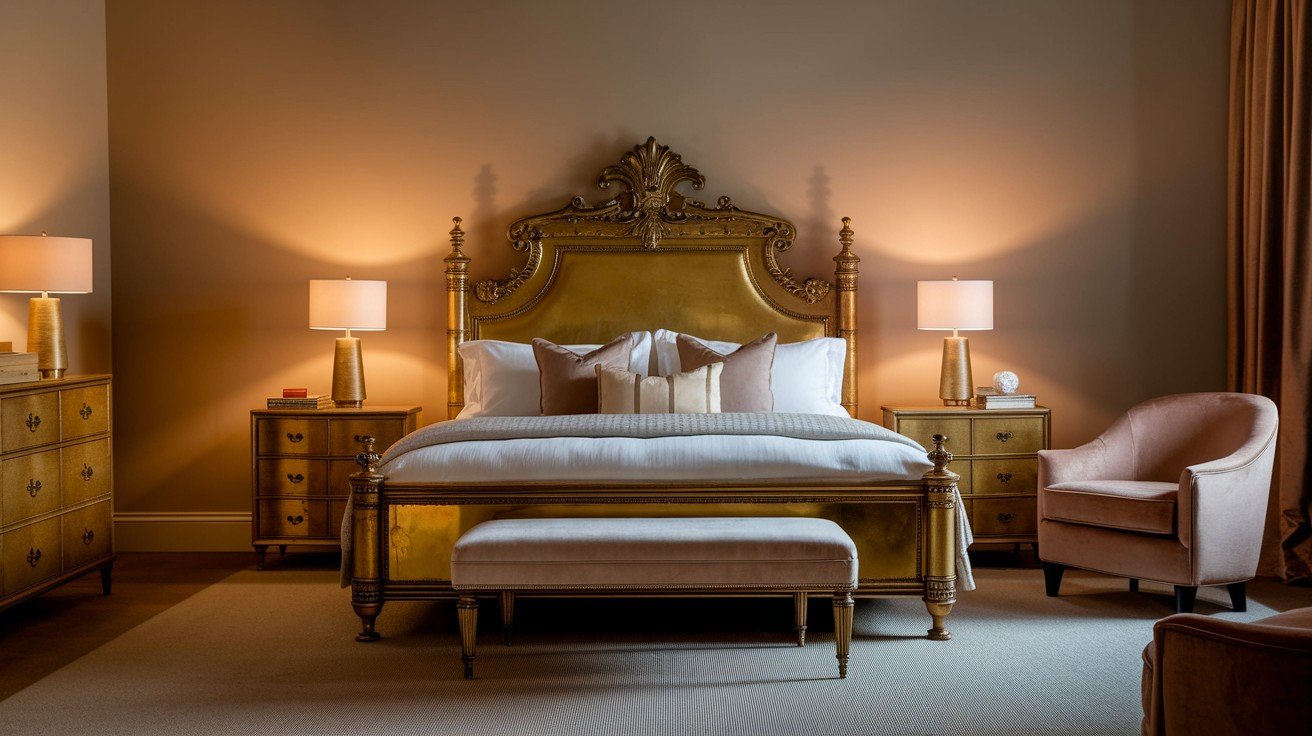
Every great bedroom needs a star. I recommend choosing one piece as your design anchor and building everything else around it. Most of the time, this should be your bed frame.
Your bed is the largest piece in the room and the first thing people notice when they walk in. Make it count. Whether you have a vintage brass frame, a modern upholstered headboard, or a rustic wooden bed, let it set the tone for everything else.
Here’s how it works. Look at your focal piece and identify its key characteristics. Is it curved or angular? Smooth or textured? Dark or light? These details become your guide for choosing other furniture.
If your bed frame has clean, straight lines, look for nightstands and dressers with similar geometric shapes. Got a bed with curved details? Add a round mirror or oval-shaped chair to echo those soft lines. Pull colors and textures from your statement piece, too.
Create a visual flow from your centerpiece to supporting furniture. The goal isn’t to match everything exactly, but to create connections that make sense. Your eye should move smoothly from piece to piece, finding familiar elements that tie the room together.
4. Master the Three-Style Mix Formula
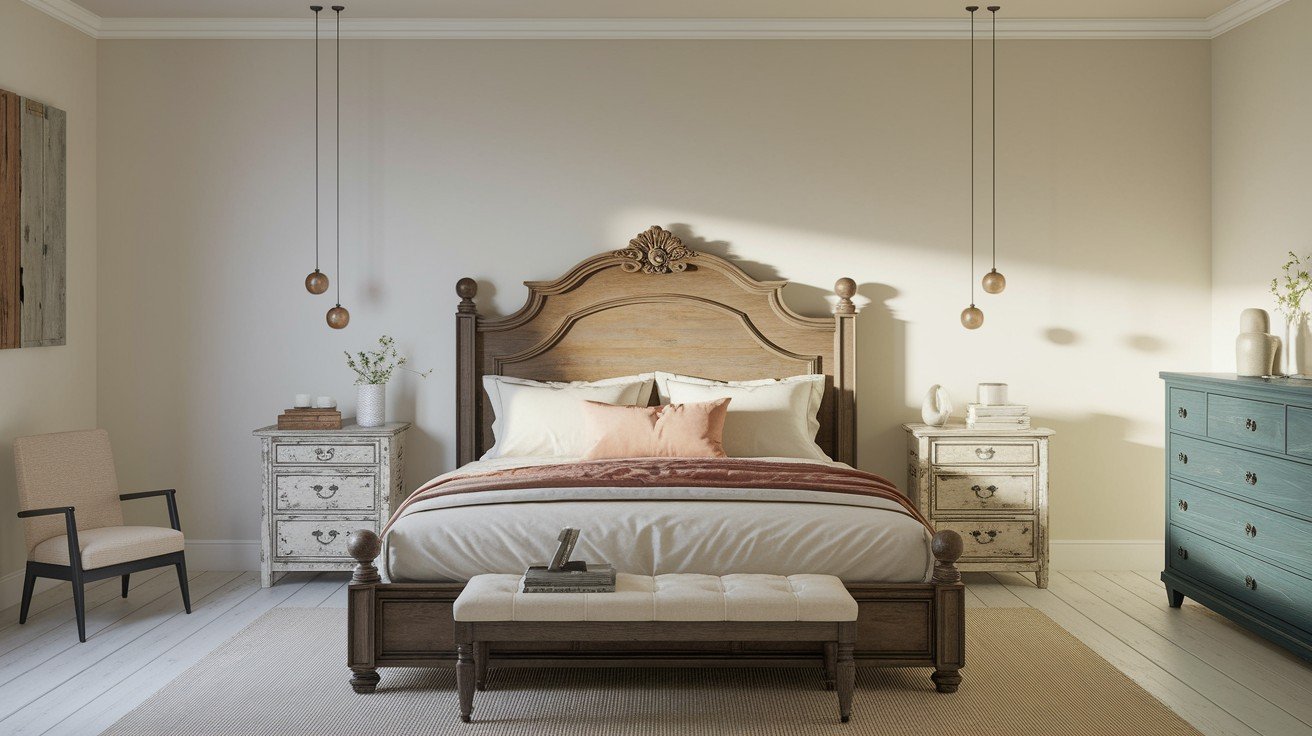
Here’s a secret designers use: Limit yourself to exactly three different furniture styles for your large pieces. More than three create chaos. Less than three can look boring.
I call this the three-style mix formula, and it works every time. Pick three styles that complement each other, then stick to them throughout your room. Good combinations include modern with vintage and industrial, traditional with contemporary and rustic, or mid-century with farmhouse and minimalist.
The key is being intentional. You’re not accidentally mixing styles because you inherited furniture from different relatives. You’re making curated choices that create a specific look.
Try pairing vintage nightstands with a modern dresser. The contrast adds visual interest while the shared clean lines keep everything cohesive. Or mix a traditional bed frame with contemporary storage solutions for a room that feels both timeless and current.
Think of it like cooking. Too many ingredients make a messy dish. But the right combination of three flavors creates something memorable. Your furniture should work the same way.
The formula helps you make decisions, too. When you’re shopping for a new piece, ask yourself which of your three styles it fits. If it doesn’t match any of them, keep looking.
5. Use Scale and Proportion Strategically
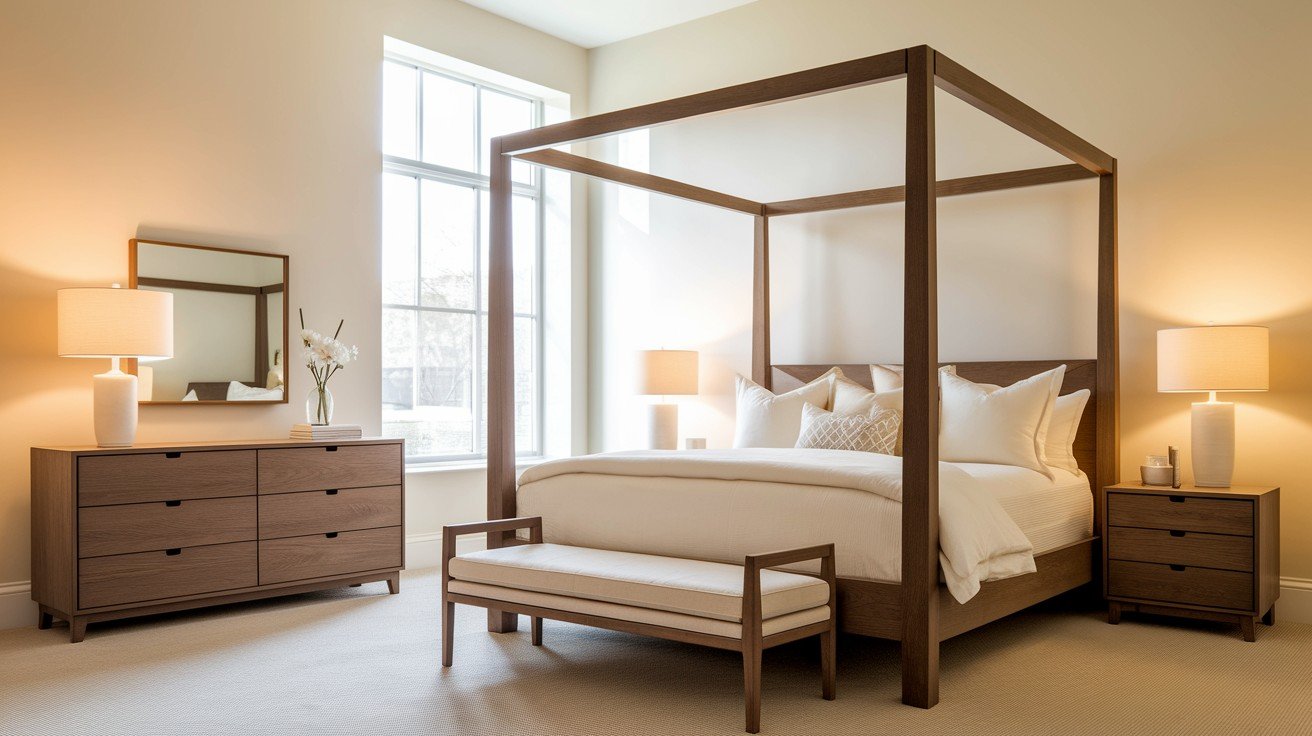
Size matters when mixing furniture. I’ve seen beautiful individual pieces look terrible together simply because their proportions were off. A tiny nightstand next to a massive bed frame creates an awkward imbalance that makes the whole room feel wrong.
Start by maintaining appropriate size relationships between your pieces. Your nightstands should be roughly the same height as your mattress top. Your dresser shouldn’t dwarf your bed or disappear beside it.
Here’s what works: If you have a large, heavy bed frame, choose substantial nightstands and dressers to match its visual weight. Got a delicate, airy bed? Pick lighter-looking pieces that won’t overpower it.
Different furniture heights can work well together if you balance them strategically. Use accessories and lighting to bridge the gaps. A tall lamp on a short dresser brings it up to eye level. A low bench at the foot of a high bed creates a nice stepping stone for your eye to follow.
Measure your floor space before buying anything new. Write down your room dimensions and take them shopping with you. Create visual weight distribution across the room by spreading heavy, dark pieces around so the room feels balanced from every angle.
6. Unify Through Paint and Hardware Updates
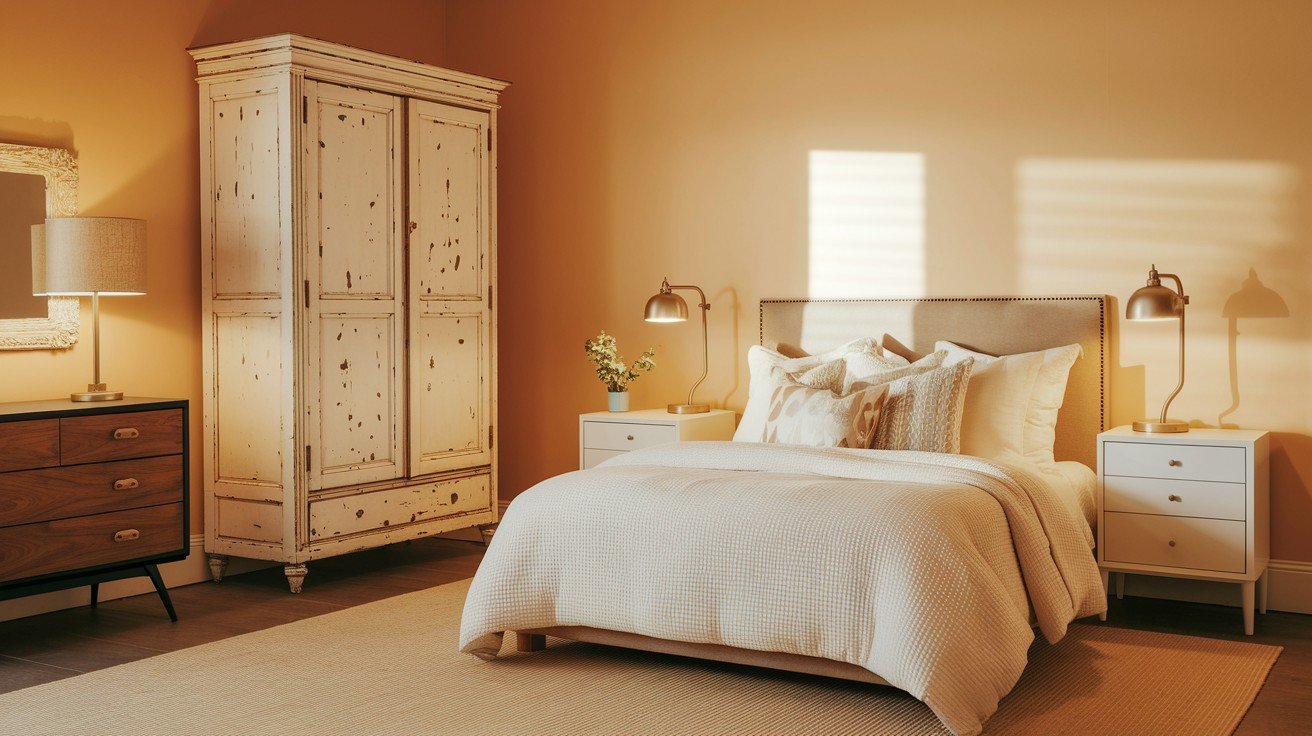
Sometimes the simplest changes make the biggest difference. I’ve watched people completely change their bedrooms with nothing more than a can of paint and new drawer pulls.
Paint is your best friend when dealing with mismatched furniture. You can take pieces from different decades and make them look like they were designed together. The key is using coordinated paint treatments across multiple pieces.
Here’s a smart trick: Paint the legs of different furniture pieces the same color while leaving the tops in their original wood stains. Your oak dresser and cherry nightstand suddenly become a matched set when their legs are both painted crisp white.
You don’t need to paint entire pieces either. Try painting just the frames of mirrors, the bases of lamps, or the trim details on furniture. These small touches create visual connections without overwhelming the room.
Hardware makes a huge impact, too. Replace all your drawer pulls, cabinet knobs, and handles with the same finish and style. Brushed gold hardware on your dresser, nightstand, and armoire instantly makes them look like they belong together.
The goal isn’t to make everything identical. You want intentional coordination that lets each piece keep its personality while working as part of a team.
7. Use the Strategic Pairing Technique

Your eye loves to find patterns. I use this fact to make mismatched furniture look intentional by creating pairs of accent elements throughout the room.
The technique is simple. Pick small items that you can repeat in two or more places. These paired elements create visual bridges between your different furniture pieces, making them feel connected even when they’re completely different styles.
Matching throw pillows work perfectly for this. Place the same pillow pattern on your bed and in your reading chair. Suddenly, your modern bed frame and vintage armchair look like they were planned together. Your brain sees the repeated element and assumes everything belongs.
Try repeating artwork frames or lamp styles for stronger visual connections. Two identical table lamps on different nightstands will tie those pieces together, even if one nightstand is wood and the other is metal.
The magic happens in threes, too. Repeat an element three times around the room for even stronger connections. Three matching vases or similar throw blankets create a rhythm that makes everything feel purposeful.
This technique makes unusual pieces appear intentional rather than out of place. That quirky vintage stool suddenly looks like a deliberate choice when you add a matching throw pillow to tie it to your bedding.
Conclusion
Creating a cohesive bedroom with mismatched furniture is easier than you might think. You don’t need to spend a fortune on matching sets to have a room that looks put-together and reflects your style.
The seven ideas we’ve covered give you practical ways to make any combination of furniture work. Focus on connecting your pieces through color, texture, or style elements. Small changes make big differences.
Remember, your bedroom should feel like your space. Mismatched furniture often creates more character and personality than identical pieces ever could. Trust your instincts about what feels right to you.
Start with one or two of these techniques and see how they transform your room. You’ll be surprised at how quickly your random furniture pieces start looking like they were meant to be together all along.
Frequently Asked Questions
Can I mix different wood tones in one bedroom?
Yes, but choose either warm or cool undertones consistently and avoid similar competing shades.
How many different furniture styles can I combine safely?
Three different styles for large pieces work best – more creates chaos and a lack of interest.
Should nightstands match each other in mismatched bedrooms?
Not necessarily – different nightstands work if they share color, material, or scale similarities.
What’s the biggest mistake when mixing bedroom furniture?
Trying to match patterns or textures imperfectly instead of choosing completely different, complementary elements.
How do I know if my mismatched furniture looks intentional?
Each piece should connect to others through color, material, scale, or style – avoid isolated elements.

